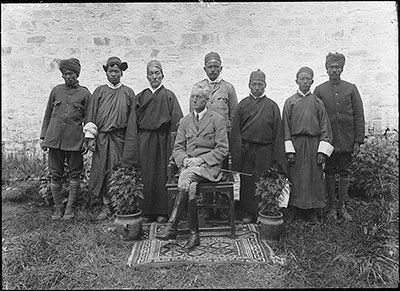Name Charles Bell Died 1945, Victoria, Canada | ||
Books People of Tibet, The Religion of Tibet, Grammar of colloquial, Portrait of the Dalai Lama, Students English‑Tibetan Colloquia | ||
Sir Charles Alfred Bell, KCIE CMG (October 31, 1870–March 8, 1945) was the British Political Officer for Bhutan, Sikkim and Tibet. He was known as "British India's ambassador to Tibet" before retiring and becoming a noted tibetologist.
Contents

Biography
He was educated at Winchester School and then at New College, Oxford, after which he joined the Indian Civil Service in 1891.
In 1908, he was appointed Political Officer in Sikkim. He soon became very influential in Sikkimese and Bhutanese politics, and in 1910 he met the 13th Dalai Lama, who had been forced into temporary exile by the Chinese. He got to know him quite well, and later wrote his biography (Portrait of the Dalai Lama, published in 1946).
In 1913 he participated in the Simla Convention, a treaty between Great Britain, China and Tibet concerning the status of Tibet. Before the summit, he met in Gyantse with Paljor Dorje Shatra, the Tibetan representative to the British Raj at Darjeeling and advised him to bring to Simla with him all documents concerning relations between China and Tibet, as well as Tibetan claims to land occupied by China. Bell was designated to assist the Tibetans in the negotiations, with Archibald Rose assigned to be his counterpart for the Chinese. He was appointed a Companion of the Order of St Michael and St George (CMG) in the 1915 New Year Honours for his services.
In 1919 he resigned as Britain's political officer in Sikkim to devote himself full-time to his research. However, London sent him to Lhasa in 1920 as a special ambassador.
After travelling through Tibet and visiting Lhasa in 1920, he retired to Oxford, where he wrote a series of books on the history, culture and religion of Tibet. He was awarded a knighthood for his Lhasa Mission in 1922.
Palhese, Bell's Tibetan friend and confidant travelled to England in 1927-28 to assist him in editing several of these books.
Some of the photographs that he took in Tibet can be found in the Pitt Rivers Museum in Oxford. Some of these were included in the 1997 book Tibet: Caught in Time.
His English-Tibetan colloquial dictionary was first published in 1905 together with a grammar of colloquial Tibetan as Manual of Colloquial Tibetan.
Peter Fleming mentions Bell in the introduction to the book Seven Years in Tibet by Heinrich Harrer, Flamingo imprint 1997, specifically his surprisingly close relationship to the 13th Dalai Lama even though he was a foreigner.
